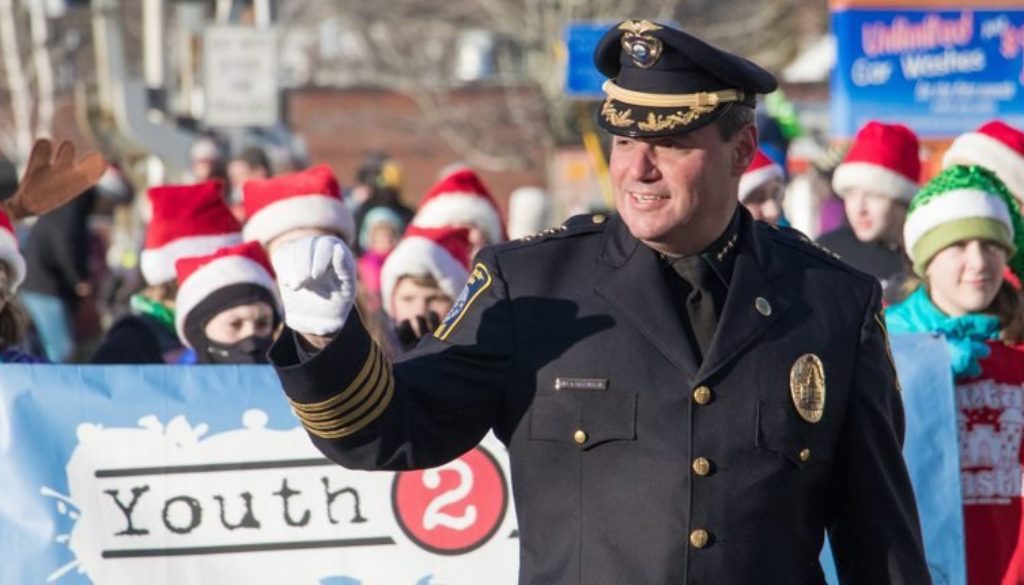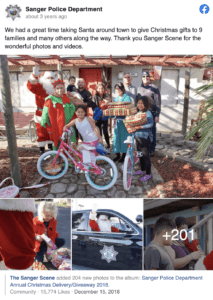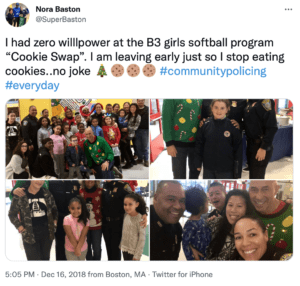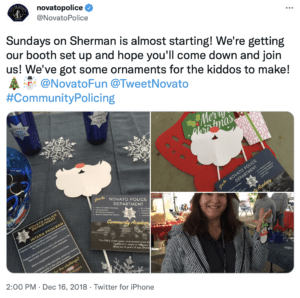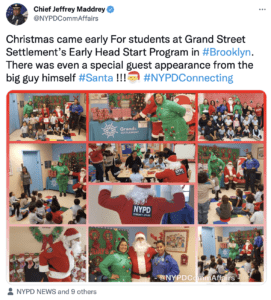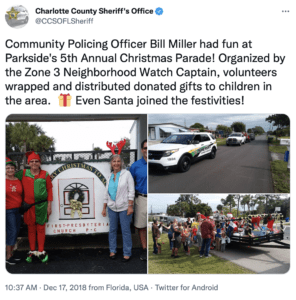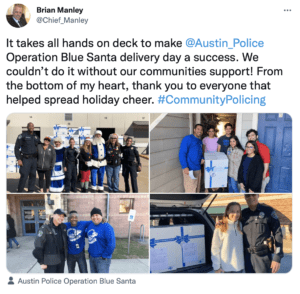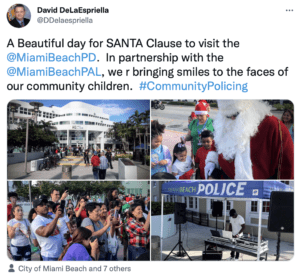7 Acts of Community Policing Around The Holidays and Beyond
Updated on 12/19/2018—The holidays are a time to give back. The season inspires people to contribute to their communities in the form of time, like a volunteering commitment, or resources, like a donation to an important charity or cause. This time of year also presents many opportunities for law enforcement professionals to connect with the neighborhoods they work in. Across the country, many local police departments have already invested in community policing initiatives to do just that. These programs give officers the chance to meet and communicate directly with citizens, and better understand and serve the neighborhoods in their community.
What is Community Policing?
What is community policing, and how can law enforcement participate during the holiday season? Community policing, or community-oriented policing, is a strategy that focuses on building trust between citizens and law enforcement through mutual understanding and collaboration. These community policing programs are also meant to encourage partnerships between local police and first response teams, local government, non-profits and other organizations, small businesses, and most important of all, citizens. In towns and cities across the country, community policing is becoming a crucial common practice.
How Does Community Policing Help?
Community policing measures are helping law enforcement better manage safety in their communities, while enabling citizens to have a voice in public safety management. It helps ensure that communities are served by culturally-fluent cops who approach their work in a way that is empathetic and with the best interests of the people in mind. There are lots of ways to participate and different types of community policing. These community policing programs can help build key relations between law enforcement officials and the community.
The holidays, with toy drives, holiday gatherings, and increased time for community meetings, are the perfect time for law enforcement to get more in touch with neighborhoods they’ve sworn to keep safe. The season of giving is also an opportunity for local safety managers to provide much-needed assistance for more vulnerable communities.
Here are 7 real community policing examples so far this holiday season:
1. Santa Gift Delivery – Sanger, California
In Sanger, California, the Sanger police Department participated in the annual Christmas delivery and giveaway. The department took the time to take Santa around town to give gifts to 9 families and other residents along the way. The department even had a full Santa and elf costumes to make the event more festive.
2. B3 Girls Softball Program Holiday Cookie Swap – Boston, MA
I had zero willlpower at the B3 girls softball program “Cookie Swap”. I am leaving early just so I stop eating cookies..no joke 🎄🍪🍪🍪 #communitypolicing #everyday
— Nora Baston (@SuperBaston) December 16, 2018
In Boston, local officers attended a cookie swap run by a local sports team. The Deputy Superintendent of the Boston Police seemed to have a great time at the event and shared several photos with other officers and local students.
3. Kids Community Holiday Party – Novato, California
Sundays on Sherman is almost starting! We’re getting our booth set up and hope you’ll come down and join us! We’ve got some ornaments for the kiddos to make! 🎄☃️ @NovatoFun @TweetNovato #CommunityPolicing
— Novato Police (@NovatoPolice) December 16, 2018
In Novato, California, local officers plan and coordinate events for both children and adults. Their initiatives include Sundays on Sherman program, an outdooor community gathering meant to strengthen bonds within the community. This year, the Novato Police Department provided ice skating, food, and an ornament making event for local kids to make.
4. Santa Makes A School Visit – Brooklyn, New York
Christmas came early For students at Grand Street Settlement’s Early Head Start Program in #Brooklyn.
There was even a special guest appearance from the big guy himself #Santa !!!🎅 #NYPDConnecting— Chief Nilda Hofmann (@NYPDCommAffairs) December 13, 2018
In Brooklyn, Grand Street Settlement’s had an Early Head Start Program gathering in Brooklyn. The event included a special guest appearance from Santa, and is part of a greater effort on the part of NYPD to connect with local communities.
5. Annual Christmas Parade – Charlotte County, Florida
Community Policing Officer Bill Miller had fun at Parkside’s 5th Annual Christmas Parade! Organized by the Zone 3 Neighborhood Watch Captain, volunteers wrapped and distributed donated gifts to children in the area. 🎁 Even Santa joined the festivities!
— Charlotte County Sheriff’s Office (@CCSOFLSheriff) December 17, 2018
In Charlotte County, Florida, Community Policing Officer Bill Miller attended the 5th annual Christmas Parade in the community. The event was organized by the Neighborhood Watch Captain, and volunteers were at the event wrapping and distributing gifts for children in the area.
6. Blue Santa Gift Delivery – Austin, Texas
It takes all hands on deck to make @Austin_Police Operation Blue Santa delivery day a success. We couldn’t do it without our communities support! From the bottom of my heart, thank you to everyone that helped spread holiday cheer. #CommunityPolicing
— Chief Brian Manley (@Chief_Manley) December 15, 2018
The Austin Police Operation Blue Santa had another successful year. The non-profit serves the city of Austin, Texas by providing holiday gifts and toys for children 14 and under across the city. The gifts are brought to families by Santa and Mrs. Claus, and officers get to see firsthand the impact the program has in the community.
7. Santa Clause Gets Some Sun – Miami Beach, Florida
A Beautiful day for SANTA Clause to visit the @MiamiBeachPD. In partnership with the @MiamiBeachPAL, we r bringing smiles to the faces of our community children. #CommunityPolicing
— David DeLaEspriella (@DDelaespriella) December 15, 2018
In Miami Beach, Florida, the local police department partnered with the Miami Beach Police Athletic League to organize a visit with Santa. The event gave kids in the local opportunity to meet Santa, who understandably seemed to be enjoying the warm weather after all that time in the North Pole.
Year Round Community Policing Initiatives
These acts of community policing were holiday-oriented. In addition to contributing to these seasonal activities, many local law enforcement agencies continue their year-round community programming well into the winter months. These four examples of police-community relations programs are four other recent initiatives that, while not holiday-themed, capture the spirit of giving back to the community. Citizens and law enforcement alike are continuing to keep lines of communication open with their community.
1. Community Volunteer Team – Santa Cruz, California
@SantaCruzPolice on footpatrol w our new community volunteer team making @CityofSantaCruz safe for the holidays. #Neighborhoodpolicing #CommunityPolicing
— Andrew Mills (@ChiefAndyMills) December 17, 2018
In Santa Cruz, California, the police do foot patrol with the community volunteer team. The neighborhood and community policing effort not only keeps the city safer around the holidays, it can also promote understanding and trust for both officers and locals year round.
2. Alianza Against Crime Event – Houston, Texas
Another “Alianza Against Crime” reminder, featuring one of our partners, HCSO! Our bilingual event featuring police displays, resource fair, and Blue Santa! Looking forward to seeing you, this Saturday at Mason Park from 12-2pm! #CommunityPolicing #Eastside @SheriffEd_HCSO
— Jason Cisneroz (@jasoncisneroz) December 13, 2018
In Houston, Texas, the police department hosted a bilingual “Alianza Against Crime” event for the community. The event features police displays, a resource fair, and holiday festivities. The event will help community members better understand the role of law enforcement, and give officers the chance to meet with residents to hear their concerns.
3. Citizen’s Academy – Covina, California
Join us for Covina’s next Citizens Academy starting October 3rd. Applications can be found on our website or by contacting front desk staff at the station. @covinapd
— Sgt. Ryan Davis (@RyanDavisCPD) August 30, 2018
In Covina, California, law enforcement professionals host a Citizen’s Police Academy that provides citizens with information about how the police department works. The goal is to increase understanding and communication between citizens and police, and to help the police find practical solutions to neighborhood problems. The program is almost in its 20th year and builds trust between the community and law enforcement.
4. Shop With A Cop – South Burlington, Vermont
Shop with a cop. Thanks to our partners at Target! #sbvt #communitypolicing #policing #holidayseason
— So.Burlington Police (@SBPolice1) December 9, 2018
In Burlington, Vermont, officers have a Shop With A Cop program. Similar to the popular Coffee With A Cop program that has become common in communities across the United States, this event allowed residents to talk directly with local law enforcement. It’s important for officers to interact with the community in situations that are casual, since most of the communication that occurs is during an emergency. This gives law enforcement the chance to better understand residents and their concerns in a context that is more casual.
Examples of Community Policing Strategies
Community policing encompasses a variety of philosophical and practical approaches and is still evolving rapidly. Community policing strategies vary depending on the needs and responses of the communities involved; however, certain basic principles and considerations are common to all community policing efforts
Problem-Oriented
David Weisburd, a criminologist at George Mason University, recently authored a lead a new analysis on Proactive Policing Effects on Crime and Communities. Weisburd found that problem-oriented policing was one of the most promising strategies his team studied. Although there is little long-term data available for this study overall, problem-oriented community policing strategy reduces crime in the short term and improves community relations according to the evidence found. This community policing strategy is organized around all officers can use to identify problems and develop potential responses.
Arizona State University’s Center for Problem Oriented-Community Policing is working to promote the concept in communities by providing resources to help effectively address specific crime and disorder problems. This organization, along with a number of training agencies, advocate for the SARA model for successful problem-oriented policing. The SARA model is a decision-making model that incorporates analysis and research, tailoring solutions to specific problems, and most importantly, evaluating the effectiveness of those responses. The acronym SARA stands for:
- Scan for underlying problems that may require police attention;
- Analyze each problem to determine its root causes and contributing factors;
- Respond to the problem using a combination of traditional enforcement tactics and nonenforcement approaches;
- Assess the extent to which the response addressed the problem at issue.
Hot Spots Policing
Used by a majority of U.S. police departments, hot spots policing strategies focus on certain city streets and small places “in which the occurrence of crime is so frequent that it is highly predictable, at least over a one year period” according to the National Institute of Justice. Hot spot community policing programs invest in these streets more intensely—and studies show that the strategy helps reduce crime there in the short term, without pushing off crime to surrounding areas.
The observation that crime tends to happen in certain locations rather than evenly spread across areas is not a new concept. However, recent interest in this type of community policing has spiked because technology has made it easier to track and analyze crime data. Hot spot policing can adopt a different community policing types to help control time in these areas. Hot spot combined with problem-oriented is a community policing strategy that represents police-led efforts to change the underlying conditions at hot spots that lead to recurring crime problems. This involves examining traditional strategies in place and seeing where community improvements can be made. The second hot spot community policing approach relies on enforcing traditional policing strategies that prevent crime through general deterrence and increased risk of apprehension, such as increased vehicle and foot patrols.
The holiday season presents unique opportunities for local safety managers to reach out to their communities, but community policing efforts can be instituted year-round. If a city or town makes a commitment to community policing, it can help improve lines of communication, bonds of trust, and improve overall community safety.

